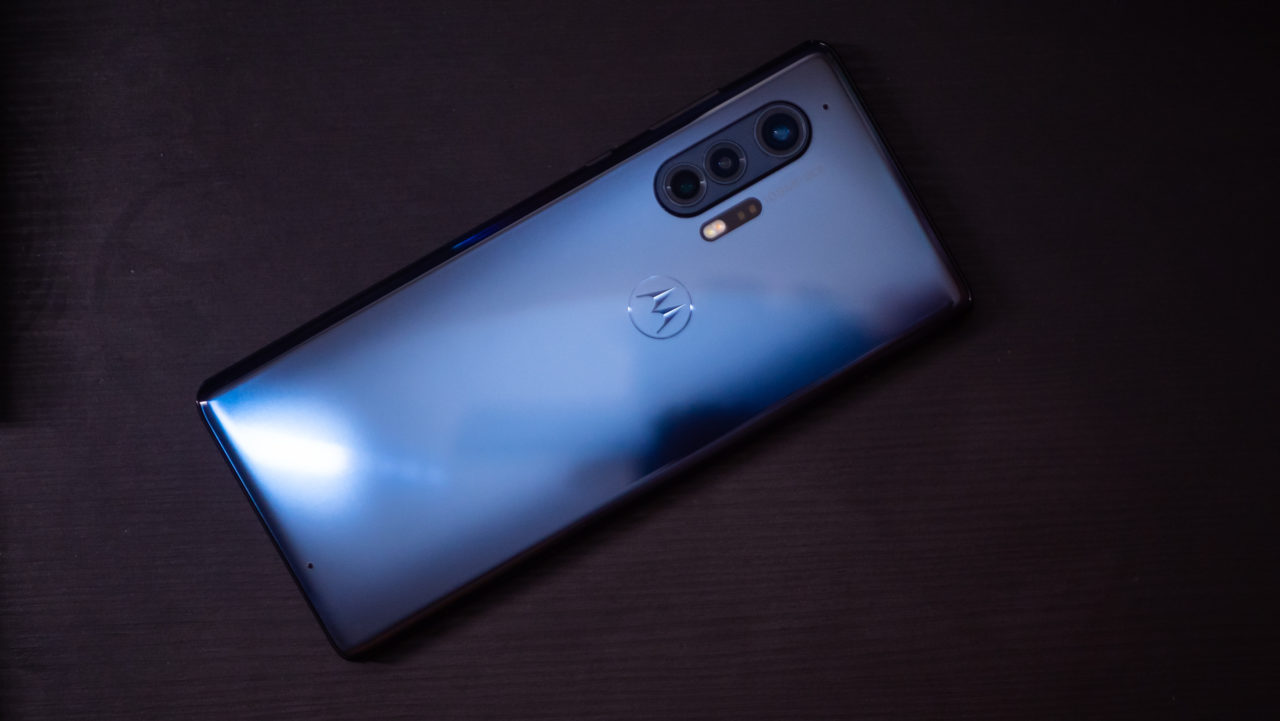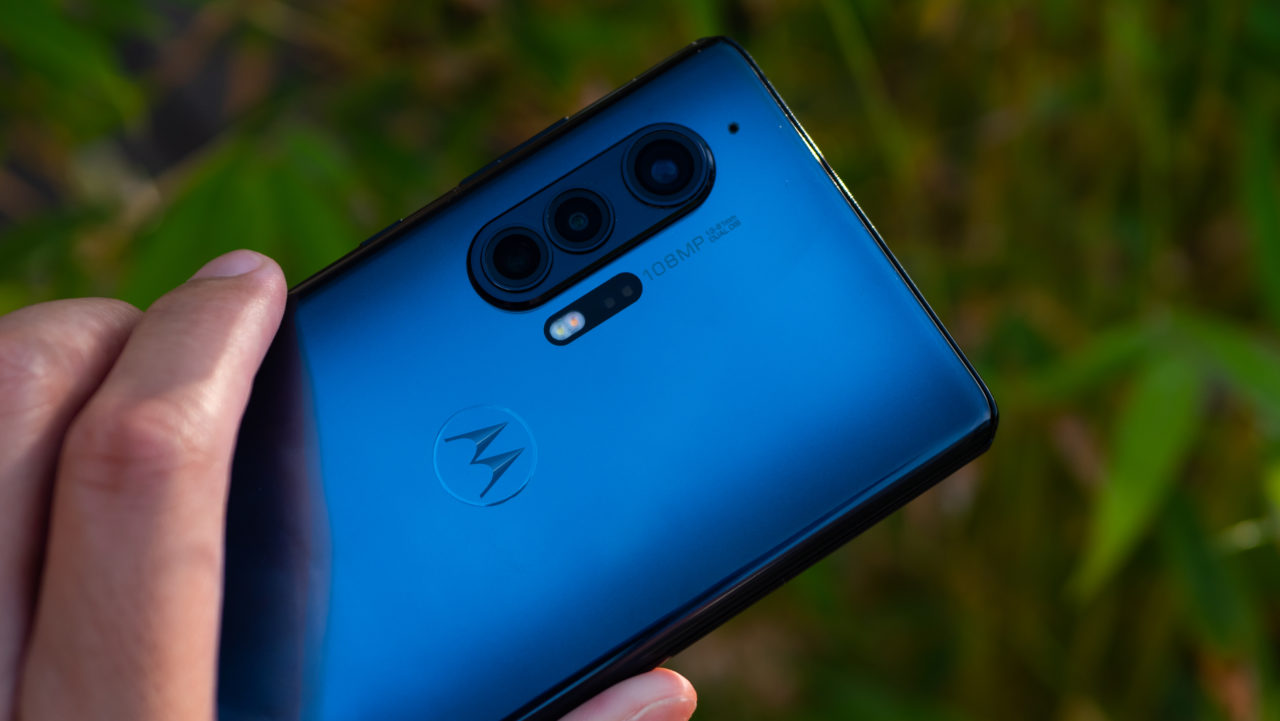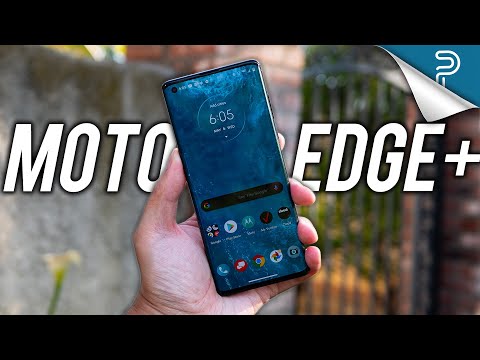Moto is one of those companies that is just always around, for better or worse. Especially here in the US, their continued partnership with carriers like Verizon keep them at the forefront of a lot of users’ minds. But the last few years have seen the company focus on affordable accessibility rather than true flagship prowess. We all know they’re capable of it, but it isn’t until now that we see just how much of an edge Moto could have.
A return to form
Gone are the Xs and the Zs and perhaps most importantly, the Mods. Motorola has returned to just making a good looking phone rather than struggling to adhere to a standard of POGO pins and connectors that made their design language too rigid. The result is a simpler back design even if the front takes some big risks. But I do love the way that this one turned out, with the Moto logo still prominently shown on top of the shiny blue gradient. The camera bump isn’t too egregious and it does a good job of highlighting that big sensor up at the top. The top and bottom portions of the phone are sizeable, complete with a bit of a dip in the middle that actually makes resting the otherwise dense device on a pinky quite comfortable. A headphone jack is found up top and then the phone is thick enough that the phone can literally stand up on its own.
Now, the sides are really thin from a button standpoint — the volume rocker and the power button are really thin in order to give enough room for the Edge display. Yes, you see it right here folks — waterfall displays have come back to the US market. The last time that I saw something like this was with the Vivo NEX3 5G — and the big problem with that phone was that there were no buttons at all and it was such a big device that handling it was harder than any phone should be. As impressive as having all of this display might be, the handling shouldn’t be a big diminishing return.
And to that end, I commend Moto for not going too big on the screen and the footprint of this phone. The display on here is an OLED panel at Full HD+ resolution, with a welcome 90hz refresh rate. It’s a slender one, opting for a narrower screen so that getting a good grip on the phone isn’t too bad. This means a more acute aspect ratio overall, but that hasn’t stopped any viewing experiences from being enjoyable. There’s plenty of contrast and the colors are properly vibrant, and Moto’s own ambient display tech keeps the screen useful on-demand.

Don’t go chasing waterfalls
But there are some major caveats to having a waterfall display, and unfortunately Moto hasn’t really done enough to tackle those inherent issues. A display that spills over on the side adds more places for wayward touches, whether it be from your fingers stabilizing the phone in your grip or even the meat of your palm touching portions of one side while you try to reach for the other. As I mentioned, I do enjoy the handling of a phone that is this slender, but then that goodwill is chipped away little by little with every accidental input I make.
But touchy quirks actually trickle into other experiences, as well — take gaming, for instance. COD Mobile and PUBG Mobile players are well aware of various grips and playstyles like the three finger or even four finger claws. Unfortunately, the display’s abundant caution regarding accidental input means that I couldn’t really do more than two inputs at a time, making running, aiming, and shooting all at the same time basically impossible. This is unfortunately also true when using a feature that I actually applaud Moto for including — software based trigger buttons put on the very edge.
Yet another feature that Moto included actually further illustrates this problem — the Edge Panel. It’s a small little button on the very edge of the screen that you can tap or swipe from in order to trigger some shortcuts. It would be nice to use, if I could get it to work more than half the time. The precision that this feature seems to require takes away from how useful it can be.
Which is why, funny enough, one of the key options for the Edge Display is that you can turn it off. You can actually go into the settings and turn the edges black, relegating them to just extracurricular features like glowing for notifications or when you’re charging. The majority of apps will just render outside of those edges, so you won’t get that bleeding over look that seemed so futuristic in the past but is still mired in problems of present software tuning.

Puzzling pieces
So those are honestly the main things to keep in mind with the Moto Edge+ — while the Edge Display is the most unique part of the phone, it is also the one portion of the device that you might contend with the most. That’s because the rest of this phone — mostly — hits the right marks. The Snapdragon 865 with 12GB of RAM and 256GB of storage keep the phone snappy, the headphone jack will please users who miss having them in flagship phones, and the 5000mAh battery can easily hit 2 day marks depending on usage. Wireless charging at 15W is possible with this phone, with reverse wireless charging available as well. But one really weird piece of the puzzle that seems to be missing is super fast charging.
The Moto Edge+, for whatever reason, only does 18W charging. That’s not bad and you might have the phone plugged in every night anyway, but Moto themselves have HyperCharge at up to 45W charging so it’s weird to see them return to flagship form but not bring that unique feature.
Audio also gets a boost with really loud stereo speakers. Calls sounded nice and clear in both directions in the few calls I’ve actually made outside of video chats, which were fine as well. And this is a Verizon phone, which means really fast internet. Unfortunately, 5G — especially the mmWave variety — is really scarce in my location up on the side of a mountain. 4G LTE on Verizon was as good as ever, though, so even if I can’t truly sing the praises of 5G right now, I also had no complaints with mobile connectivity.

Chasing clarity
Yes, that is a huge sensor on the rear and it does a pretty great job. Moto’s camera software shows off all the different things you can do with this camera package, including those 108MP full resolution stills, a Night Sight mode for those low light shots, portrait modes thanks to the 5MP depth camera, and extra focal lengths thanks to the 16MP ultrawide and the 8MP telephoto. You get just the right amount of usability here, without going too far into gimmick territory. The main sensor does a great job of capturing detail especially if you opt for the 27MP pixel binned photos, while the ultrawide drops down in quality by a small but noticeable margin. Zoom is there if you really need it, but those 8MP results will obviously see a dip as well. A manual mode allows you to fine tune capture settings and even enable RAW capture, while other modes are available for some extra fun.
But one of the main aspects I enjoyed from this camera package is in video — 6K recording feels like Moto wading into the water to provide some extra resolution rather than diving into the deep end with 8K just because they know it’s possible. OIS keeps the footage smooth even when recording at this high resolution and I’m honestly pretty happy with the results.
It’s too bad the front facing camera doesn’t get as much love in video, as 4K recording is not possible despite the sensor being 25MP. What it does achieve is 120fps video, so Slofies are a thing on the Moto Edge. That said, selfie shots are also well detailed and some of the extra modes work with it too, like the Color Spot.
Overall the cameras are a pretty high point for the Moto Edge+, showing that with the right hardware Moto can provide a great shooting experience.
Hello again, Moto
A feeling I couldn’t really shake as I was using this phone over the last week or so was that Moto laid out most of the Edge+ and followed a template. Super high resolution camera, big battery, sleek design, and a performance spec tailormade for any flagship. It’s a good template. Then Moto started to get creative, with most hits and a couple of stumbles. Moto’s software, barring any bloatware from Verizon, is mostly spartan and does more to add to the experience rather than clutter it up. Moto gestures, the Moto Display, and further Moto enhancements are all things we’ve seen refined and improved over time. But it’s where Moto tries their hand for the first time that we see the main stumbles. The Edge Display is a great idea that made for a beautiful design, but just like we’ve seen on other waterfall displays, the implementation isn’t quite there yet. For $999 you get a lot of what a phone at that price should provide — but it’s up to you to see if the unique feature this phone is named after, for better or worse, pushes you over the edge.

